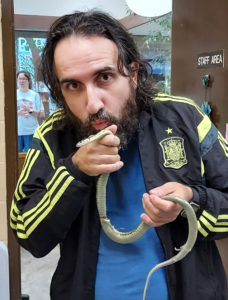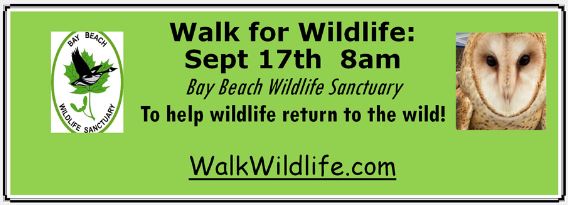By Freddy Moyano
Correspondent
BROWN COUNTY – The change of seasons is already in motion at the Bay Beach Wildlife Sanctuary, but the second week of September has been unusually slow according to Lori Bankson, curator of animals.
“With everybody back to school – college students and elementary kids – it’s quiet!” Bankson said.
She said they were far busier on Labor Day and all week long leading up to the three-day weekend.
“[Interns] Isaiah, Bailey and Devin all left. They worked hard. They’re all gone. They’re back to school, so we are really proud of them, proud of what they did,” said Bankson.
The bird migration wave is beginning to roll in according to Bankson.
“In the animal world, fall is here already. Wolves are putting on their winter coats, migration started out.
The chimney swifts left in late August, but the purple martins left in early August. So as soon as the sunlight changes and days get shorter, everybody starts going, especially the insect eaters, as insect food starts to dwindle, forcing them to move for food” said Bankson.
Wounded snake on the mend
An injured garter snake brought in from Green Bay last month is eating well and just finished shedding.
“He was caught in a net – not sure what type – but he sustained serious lacerations,” Bankson said.
The main laceration half way through its body appeared reddish, which according to Bankson is a sign that it is healing well.
She said they should be able to release him before hibernation begins at the end of October.
Bankson said the snake received antibiotics and pain medication when it came in.
It also gets regular soakings to keep its skin moist.
They keep it in an incubator, to make sure it stays warm.
Bankson said eventually the injured area will heal and the skin will fall off, so the wetter they keep the injured area, the better.
She said this is the only garter snake they have.
They have a fox snake that is also in rehabilitation.
Bankson said its diet includes insects, mice, little mammals and eggs.
“They are very opportunistic feeders,” Bankson said. “We try to mimic that diet by feeding it mice coupled with the food paste.”
Snake appreciation
Bankson said snakes are often misunderstood, but they are good for the environment.
“They won’t strike or bite unless they absolutely have to,” she said. “They are great to have around because they can clean your property of mice and insects.”

She demonstrated how to safely hold the snake, as if one were holding a basketball – one hand near the head and the other hand for support towards the tail of the body.
Bankson said snakes are attracted to heat, and the snake seemed comfortable and more active in my warmer bare hand versus Bankson’s colder glove.
“We were lucky that the public found him,” she said. “He looks a lot better than he did when he came in.”
Snowy owl update
Bankson provided an update on our March rehabilitation animal, a female snowy owl.
“The snowy is doing well,” she said. “Still not flying with enough height to migrate right now. We are going to keep evaluating the forecast for snowies for a potential winter release.”
Walk for Wildlife
The Sanctuary’s biggest fundraiser of the year, Walk for Wildlife, will take place from 8 a.m.-noon on Saturday, Sept. 17.
Participants can walk the 2.5 miles of trails past the animal exhibits, enter a raffle to win one of 30 gift baskets donated by local businesses and donors and enjoy music by Good News Band.

At 11 a.m., they will be releasing a bird of prey back into the wild.
Register at WalkWildlife.com or on the day of the event between the Nature Center and Woodland Building.
Proceeds give thousands of orphaned, injured, and sick wildlife a chance to return to the wild. The sanctuary has admitted more than 5,500 animals from the public this year.
